This masterclass session is delivered by Dr. Matthew Walker, the influential British neuroscientist and author of the international bestseller Why We Sleep. As a specialist in the study of slumber and the founder-director of the Center for Human Sleep Science at the University of California, Berkeley, he has examined how sleep affects the brain and body. He’s analyzed everything from its role in Alzheimer’s and depression to the ways it can facilitate learning and, potentially, extend our life expectancy. (Indeed, the center is a world leader in studying the effects of sleep on the mind and body.)
In sleep, he’d found his muse, a mysterious and often evasive biological phenomenon—excellent fodder for a hardcover. Why We Sleep, recommended by The New York Times for “night-table reading in the most pragmatic sense” and endorsed by Bill Gates, arrived in 2017. It was a runaway success, both stateside and overseas, launching its author into the public intellectual stratosphere (the book has sold more than 1 million copies and has been translated into over 40 different languages). Matthew proceeded to deliver a viral TED Talk, appear on CBS’s 60 Minutes and NPR’s Fresh Air, and help as a sleep consultant for Pixar and Google (among others). He’s also a Kavli Fellow of the National Academy of Sciences and was recently awarded the prestigious Carl Sagan Prize for Science Popularization.
With this masterclass, Matthew wants you to become more acquainted with sleep. He wants you to learn your chronotype, understand how snoozing impacts your memory, and figure out how sleep can slow down the physiological effects of aging. Ready to go catch those elusive Zs?
When you’re awake, your body produces adenosine, a chemical that makes you drowsy. This continues to accumulate for roughly 16 hours, until you register the feeling of exhaustion. (It takes about eight hours to clear your adenosine cache, hence the recommended nightly sleep quotient.) Once you settle down and drift off, the brain’s vital regions begin to communicate and machinate, conspiring to enable productive sleep—and facilitate dreams.
Stages of Sleep
There are four stages of sleep, divided into Non-Rapid Eye Movement (NREM) and Rapid Eye Movement (REM):
NREM STAGE 1
Transitioning from awake to asleep, very light
NREM STAGE 2
Body temperature drops, heart rate begins to slow, slow-wave sleep may occur
NREM STAGE 3
Blood pressure drops, breathing rate drops, deep, slow-wave sleep occurs
REM
Eyes move rapidly, dreaming occurs, muscles are paralyzed so that dreams cannot be acted out
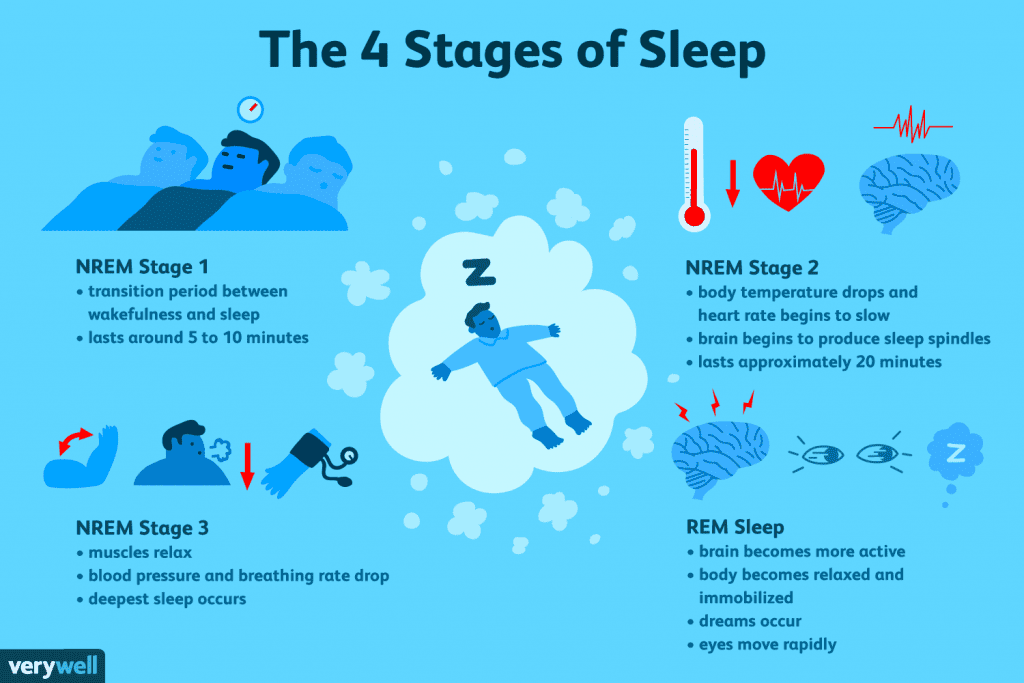
1 in 4 million
Likelihood you possess the genetic ability to feel well-rested after just four to six hours of sleep
“ I can’t get out of bed in the morning”
… is a real and chronic ailment. It’s called dysania. Technically it’s not medically recognized as a standalone diagnosis, but it often accompanies other afflictions (most commonly, depressive episodes)
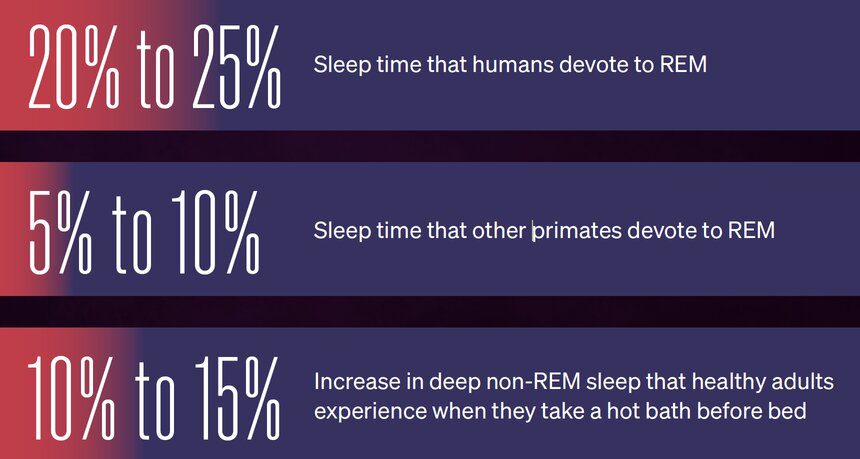
19 Hours without sleep before cognitive impairment is equal to being legally drunk
- 18 Days it takes lab rats to die from sleep deprivation
- ~800 million People in developed countries who won’t get enough sleep this week
YOU CAN’T TRAIN YOURSELF TO SLEEP LESS
In related news, the human body also never gets used to night-shift work (i.e., due to your circadian rhythm, you’re programmed to feel alert during the day and tired at night)
$411 billion Estimated annual lost income from sleep deprivation in the U.S.
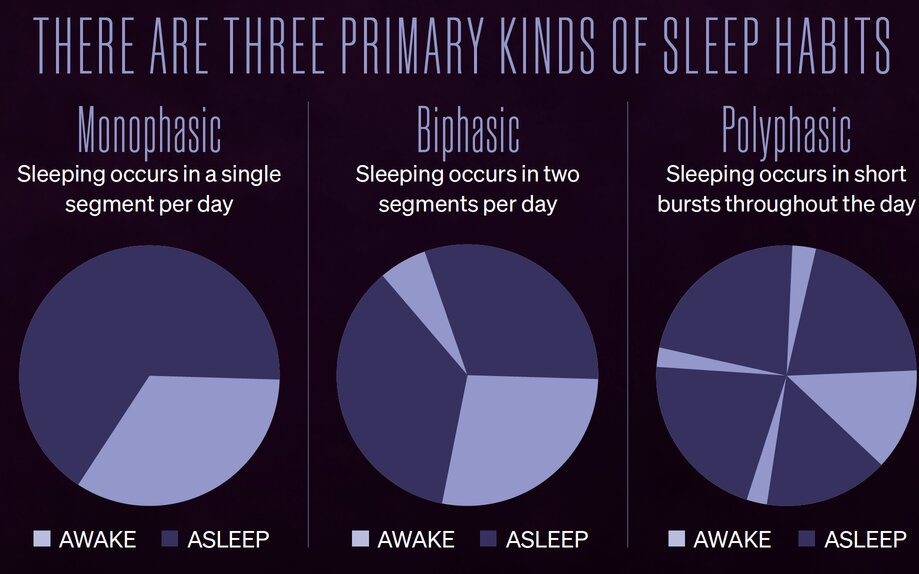
There are three primary kinds of sleep habits:
- Monophasic
Sleeping occurs in a single segment per day. - Biphasic
Sleeping occurs in two segments per day - Polyphasic
Sleeping occurs in short bursts throughout the day
Humans are the only mammals that willingly delay going to sleep
In fact, one main reason Americans report being sleepy is due to self-imposed sleep deprivation. (Who can go to bed when there are so many shows to binge?)
200%
Increase in likelihood of heart attack or stroke among adults 45 years or older who sleep fewer than six hours
1.2 MILLION
Estimated number of annual car accidents caused by sleepiness in the U.S.
25 to 30 years
Cumulative time that most humans will spend sleeping during their lifetimes
11 Days
Randy Gardner went sleepless for a Guinness World Records stunt, which is now forbidden. (Gardner, who suffered short-term memory loss, paranoia, and hallucinations, says he’s now terrified of going a single night without sleep)
Circadian rhythm
Circadian rhythm is an integral part of the biology of nearly every mammal, bird, and reptile on the planet. This internal clock helps regulate our eating and sleep patterns and is necessary for our health and survival.
Morning lark vs Night owl
From an evolutionary perspective, this makes a lot of sense: Variations in sleep patterns, called chronotypes, likely helped our ancestors survive. Staggering bedtimes would ensure that somebody was awake to alert the tribe at, say, sabertooth o’clock.
- About 30 percent of the population doesn’t have a strong, defined chronotype. But roughly 40 percent are physiologically primed to be morning larks—peak wakefulness arrives early in the day and they get sleepier earlier in the evening.
- The other 30 percent are ascribed night owls, wired for sacking out later and stirring later the following day. Unsurprisingly, this can cause problems in corporate America. For an owl who just went to bed at 3 a.m., hacking it at a nine-to-five may result in a measly four or five hours of shut-eye, depending on the commute and other morning obligations.
Morning Lark
…tend to thrive in corporate settings
Morning larks aren’t necessarily more successful, but they’re certainly better equipped to handle traditional working hours for office environments, where operating well in the wee morning hours is an asset, according to a study out of the University of Education in Heidelberg.
FAMOUS MORNING LARKS
- Oprah Winfrey
- Benjamin Franklin
- Maya Angelou
- Steve Jobs
- Flannery O’Connor
- Sir Richard Branson
Night Owls
…are more neurotic
In 2012, a survey of almost 3,000 college students in Taiwan found that night owls were more likely to be depressed, anxious, and suffer from obsessive tendencies. They also scored higher in the categories for “novelty-seeking” and “harm-avoidance.”
FAMOUS NIGHT OWLS
- Barack Obama
- Charles Darwin
- Marcel Proust
- Carl Jung
- Bob Dylan
- Emily Brontë
Be wary of coffee- and matcha-flavored foods, like yogurts and ice creams, which have upwards of 30 milligrams of caffeine per 6-ounce serving. Over-the-counter weight-loss supplements are, in many cases, glorified caffeine pills; a single tablet might contain 135 milligrams, so consider cutting them out entirely. If you’re really looking to cut down, steer clear of products branded “energy”—even bottled waters or chewing gum.
Social Jet Lag.
It’s the reason night owls forced to work in morning lark conditions can struggle with health problems, including obesity, diabetes, and heart disease. Once essential to the species, this type of chronotype variation can now be a liability—and a leading cause of chronic sleep deprivation.
The Horne-Ostberg Morning- Eveningness Questionnaire (AutoMEQ)
The Horne-Ostberg Morning- Eveningness Questionnaire (AutoMEQ), available for free online, can also place you in one of five chronotypical categories, estimate your “natural” bedtime, and pinpoint at what time each day you experience the onset of melatonin, a vital sleep hormone.
Napping
Hugely influential figures, from Albert Einstein to Winston Churchill, are said to have indulged in the act. It’s not a modern phenomenon, either; napping was written about in the Qur’an, a text dating to the 1st century.
- According to surveys, the typical American adult gets an average of six hours and 31 minutes of sleep on work nights—well below the seven to nine hours needed for a healthy system.
Keys to a Solid Siesta
1 Keep it short and sweet; you only need about 20 minutes of sleep to boost your mood and energy levels.
2 Try napping in the early afternoon; dozing off after 3 p.m. can mess with your nighttime sleep.
3 Create a restful environment; dark, quiet, and cool (around 65°F) is ideal.
Recommended App
Matthew’s Tips
- Exposing yourself to natural sunlight for at least 30 minutes a day can help regulate your sleep patterns. Aim to catch those rays in the morning, if possible, and turn the lights down before bedtime.
- Think of the ideal bedroom as a prehistoric cave in the Great North: cool, dark, gadget-free. Charge your phone in another room, get rid of electronics that cause noise, and ditch the alarm clock, which makes you hyperaware of every passing minute.
- Create a relaxing routine before bed—like reading, listening to music, or doing light stretching. “Keeping a worry journal can also help you process difficult emotions before bed.
- EAT LIGHT AT NIGHT: When it comes to late-night eating, small snacks are preferable to heavy meals, which can cause indigestion that interferes with your sleep. Don’t drink too many fluids, either, or you may find yourself in the bathroom when you could be fast asleep.
- FIND A ROUTINE: Your body’s internal clock likes to keep a specific schedule. Going to bed late one night and early the next throws your circadian rhythm off balance. Playing catchup on sleep over the weekend doesn’t work as well as you might think. It’ll take a bit of planning, but aim to dive under the sheets around the same time every night.
About Masterclass
MasterClass is a streaming platform that makes it possible for anyone to learn from the very best. MasterClass is an online membership – accessible on your phone, web, Apple TV, Roku devices, and Amazon Fire TV – that offers classes on a wide variety of topics taught by 90+ world-class masters at the top of their fields.
Their immersive learning experiences combine incredible video content, downloadable materials, and social interaction with the MasterClass community, all of which users can explore at their own pace.
The annual membership is available for $180 USD, which allows unlimited access to ALL on demand MasterClass content for the year
Give One Annual Membership. Get One Free.
MasterClass Annual Membership for only $180 USD
All the best in your quest to get better. Don’t Settle: Live with Passion.
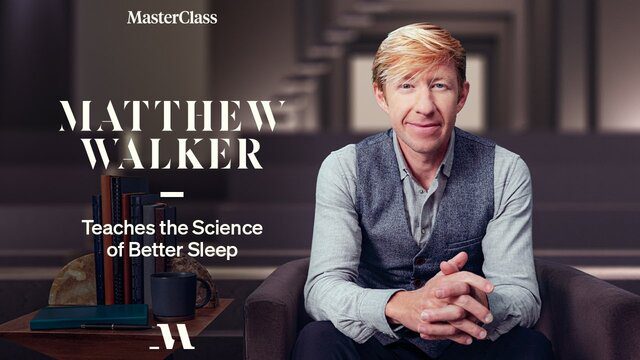

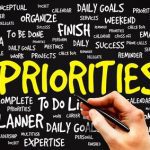
Comments are closed.